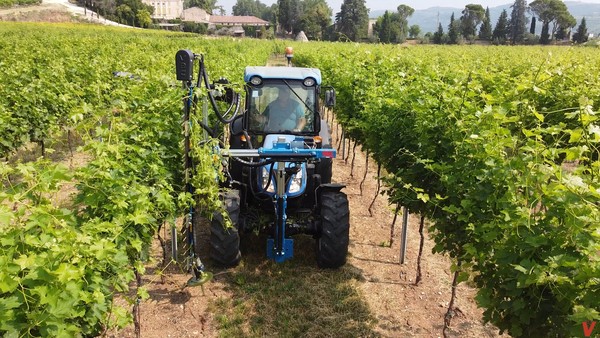
Pruning machinery for vineyards and orchards
Whether you choose to mechanize pruning fully or carry out pre-pruning, many types of machinery are available on the market. Nevertheless, each of them shows advantages and disadvantages. Hence it is necessary to carefully evaluate in advance the agronomic purposes of cultivation according to the type of farming
In both vineyards and orchards, pruning's main objective is to ensure the best product consistency over the years and an effective balance between the vegetative activity of the plant and fructification. The secondary objective (but not less important) is regulating the development of the aerial part of the plant, both to facilitate the passage between the rows and because well aerated and illuminated crowns undoubtedly reduce the onset of diseases.
In vineyards, in particular, pruning is usually carried out twice a year for different purposes: winter pruning, usually carried out during the vegetative rest, and summer pruning, generally in July. Contrary to most of the orchards, for which winter pruning is undoubtedly the main one, for the vine is also essential summer pruning, which is very vigorous cultivars (such as Merlot), can be carried out more than once.
Summer pruning
In vineyards, summer pruning is a fully mechanized process for the more common forms of farming, thus requiring less workforce. As a matter of fact, for green foliage management, the market offers a complete range of equipment for topping, stripping, and suckering. More recently, the machinery has evolved by installing control devices (feelers, photocells, video cameras), with a significant improvement in the quality of interventions, now comparable with the manual execution of this operation.
Winter pruning
Also known as "dry pruning", it includes all the cutting operations carried out during the vegetative rest. This process, in most cases, is still not 100% mechanizable, at least if results comparable to manual execution are to be obtained. In this case, working exclusively with skilled labor, the low operational capacity that results can lead to an advance and/or a postponement of the intervention compared to the optimal time. For example, late pruning, almost close to the so-called "weeping" (i.e., the release of sap from the cuts), delay the following sprouting. Besides, this secondary effect can also be exploited as a valuable strategy to avoid damages in areas more subject to late spring frosts.
After harvesting, manual pruning is the most expensive process in terms of human resources. Therefore it is essential to reduce the cost of pruning by using more and more mechanization.
It is, therefore, appropriate in most cases to opt for a mechanical pre-pruning with subsequent manual finishing performed contextually or at a later time.
As a matter of fact, the fully mechanized pruning is only to be applied to some types of farming, such as the free cordon, the casarsa, the double curtain, and the spurred cordon. Anyway, it is less effective than the manual one, and unfortunately, it leaves a high number of viable spurs, with an increase of buds and a consequent decrease in their fertility. The number of bunches increases (and often the number of grapes produced as well), but their size will be smaller and usually lower in sugar and aromatic and coloring compounds.
The technical account
The pruning time reduction ranges from 50 to 75% with the mechanical pre-pruning with hand finishing, up to 90-95% for the integral one. With a relatively expensive investment for machinery, the workforce reduction is enormous: from 80-100, it comes down to 4-5 hours/man per hectare.
Therefore the current agronomical orientation is to fully mechanically prune the vines in order to obtain a high production. However, mechanical pruning with manual finishing is more frequently preferred. The only manual mode is used to produce high-quality wines or for small vineyards cultivated more for passion than for income.
Types of pruners
Driven by the tractor's hydraulic system, the cutting components of mechanical pruners are of different types but can be roughly summarized as cutter bars, rotating discs, and rotating knives.
Cutterbar models are mounted on a frame, sometimes overhanging, fixed to the front or side of the tractor to allow for easy control by the driver. Alternatively, the same blade holder frames can be installed on grape harvesters converted into tool carriers after removing the harvesting module. The cutting components are either oscillating blades and fixed counter-blades, or double oscillating blades (for greater cutting efficiency), or blades sliding in guides with fixed counter-blades.
The bars' position (inclination and height) can be adjusted manually or through hydraulic controls, often gathered on a practical joystick. To prevent the accumulation of shoots in the cutting area, it is usually necessary to proceed with minimal forward speed, between 0.5 and 1.5 km/h. However, cuts have clean margins with this type of machinery and can therefore be more quickly healed. The assembly and positioning of more than one cutter bar (2-4) together with the use of specific accessories (such as removers and feelers to move the blades along the poles), makes these pruners easily adaptable to the most popular types of farming, so as to be profitably used also for summer pruning.
These models are generally equipped with mechanical feelers for winter pruning on the espaliers, which prevent damage near the poles and vine stems. More recently, optical sensors have also been adopted to identify the braces.
A useful accessory is the leaf stripper, a set of combs (with a variable number of vertical rods) capable of penetrating the foliage to remove cut shoots. They, too, are subject to rotation when approaching a pole and then return to the working position thanks to specific springs.
Rotating disc pruners are machines optimized to operate on-wall-mounted forms of cultivation using a trenching frame equipped with two vertical counter-rotating shafts, driven by hydraulic motors, which are placed on the sides of the row. They mount a series of discs with cutting edge, reciprocally staggered, so that the working parts opposite each other can act as blade and counter-blade.
Another alternative to this solution is a rotor equipped with discs and one opposite, equipped with counter-thrust wheels. Anyway, the disc pruner ensures good cutting quality and requires careful maintenance of the plant to avoid damage to the support wires. Finally, it should be borne in mind that the weight of the equipment is greater than that of the cutter bars, so that stability problems may arise in steep slope situations. As a rule, each shaft supports 6 to 10 cutting elements, taking on different conformations. Their typical action makes it redundant to use pruning cutters, as the working parts effectively chop up the pruning residues. In recent years, these models have also been fitted with sensors (e.g., photocells) to improve the evenness of the cut, even on very short spurs, and to act with greater precision near piling.
On the other hand, pruners with rotating knives use cutting organs that counter blades can sometimes complete. In the scissors-type (i.e., equipped with counter-knives), the blades (usually between 4 and 7) stay fixed, while others are mounted opposing each other on a rotor, so the cutting wires touch each other. A real advantage of this type is the ability to work at high forward speeds (4-8 km/h), with no danger of flooding. They are suitable for both dry and green pruning, and this makes them more quickly depreciable. However, for optimal operation, the knives' very high rotation speed is necessary (2000-3500 rpm). Therefore, it is essential to carry out thorough maintenance and frequent checks on the wear and tear of moving parts to avoid breakage, which may also have dangerous consequences. However, the cut made on the vegetation is not perfectly clean, and this factor extends the healing time.
After pruning
To avoid unwanted pathogens from the cuts, it is advisable to carry out specific treatments, usually with copper products. It is also an excellent rule to frequently wash the equipment with a solution of water with quaternary ammonium salts at 1% concentration to prevent the spread of wood diseases, such as esca disease.
The costs of pruning machines
There are substantial differences between the different types and models. They range from 5-6.000 euro for simple double bar models without feelers or removers, up to 35-40.000 euro for overthrowing models with optical sensors and a high level of automation.
For the finishing solution and the pre-harvesting, the average costs of the trucks already equipped with compressor and three pneumatic scissors approximately range from 5-to 6.000 euro.
Adjustments
In order to avoid aging phenomena and excess production, the cutting organs should be kept as close as possible to the cordon also to avoid creating grazing wounds and maintain stumps with a length at least equal to the diameter of the cutting area.
In dry pruning, it is also necessary to consider the sensitivity to cold of each vine, acting just before the vegetative recovery on the varieties most sensitive to frost to promote more rapid healing of wounds.








